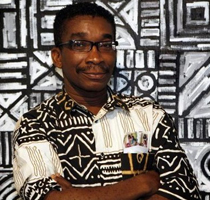The Politics of Exclusion: The Undue Fixation of Western-Based African Curators on Contemporary African Diaspora Artists
Rikki Wemega-Kwawu
(Part 1)
There is a new phenomenon emerging in Europe and America as regards the curating of contemporary African art shows and the publication of surveys on the subject. It is without doubt that African artists living in the West are being preferred, and given better exposure, well above their counterparts still living in Africa. If it is an exhibition, the number of foreign-based artists always outweighs the number of continental-based African artists. If it is the latest book survey on contemporary African art, it is all about African Diaspora artists, dotted with one or two well-known names based on the African continent. Contrary to what is actually happening on the ground, it is nearly always the same representative names re-circled from one show to the other, and from one book publication to the other, as if contemporary African art is caught in a static freeze of a granite rock. This emergent development of contemporary African art curatorship is seemingly innocuous but, indeed, harmful and, increasingly and insidiously, detrimental to the growth of contemporary art on the mother continent, even though some may argue that these African Diaspora-biased contemporary African art shows have put contemporary African art on the world map and that there is a resurgence of interest in African art. But the truth is, the negatives totally outweigh the positives. Some African curators and writers living in the West are actually responsible for this deceptively positive but degenerate trend in the development of African art.
The latest in this line of lop-sided contemporary African art exhibitions is the blockbuster exhibition, dubbed, Who Knows Tomorrow, which took place in the German capital of Berlin. For the benefit of readers who may not know about this show, I would like to give an overview of it before I veer into the substantive issue for this article, which was sparked off when I was reviewing the exhibition and its accompanying catalog (book).
Who Knows Tomorrow
On September 26, 2010, the curtains were sadly brought down on the blockbuster contemporary African art exhibition, Who Knows Tomorrow, in the German capital, Berlin. For four months and throughout the summer, Berliners and visitors to Berlin were treated to this spectacular show. Five leading African artists, El Anatsui, Zarina Bhinji, António Ole, Yinka Shonibare MBE and Pascale Marthine Tayou had their works prominently displayed in four of Berlin’s State Museums, with each artist’s work confined to one museum. El Anatsui was at the Old National Gallery on the Museum Island; António Ole at the Hamburger Bahnhof, the Museum of Contemporary Art; Pascale Marthine Tayou at the beautiful Mies van der Rohe – designed New National Gallery near Potsdamer Platz and Yinka Shonibare at the Friedirichswerdersche Kirche, the latter being the first contemporary artist to be featured in this historical German space, now a branch of the National Gallery (Nationalgalerie).
This year 2010 actually marks 125 years of the infamous Berlin Conference, which split Africa into bits and pieces and began the scramble for the continent, from which yoke and bondage the African continent is still reeling and struggling to extricate itself in spite of all the liberation struggles of the 20th Century. With this exhibition Germany has confronted its responsibility for its colonial history as well as the post-colonial present by inviting African artists into its special spaces closely synonymous with its self-image and national and spiritual identity. This would have been unimaginable 150 years ago; not even in your wildest dreams. Indeed, Who Knows Tomorrow? At that infamous conference, there was not a single African present when that dastardly decision of Europe was taken to move in to annex the African continent. Whoever thought 150 years hence, Germany would be gleefully sharing some of its most sacred spaces with Africa. What a wonderful way to reflect on Germany’s shared history with Africa, and contemplate its future bilateral relationship with the continent.
None of the artists represented in Who Knows Tomorrow should need any introduction. They are all internationally renowned and their works have been shown all over the world and are in major museum collections. El Anatsui was born in Anyako, Ghana in 1944 and today lives and works in nearby Nsukka, Nigeria. That his work, actually a close-up shot of his installation at the Old National Gallery (Alte Nationalgalerie), taking the front cover of the August issue of Art in America (the special 2010 guide to galleries, museums and artists), speaks volumes and should attest to his international stature as an African artist and one of the foremost sculptors of our time. The new high-rise building of the Museum for African art on the Museum Mile in New York City will be inaugurated next year with a retrospective of forty years of Anatsui’s work from April – July, 2011. The show dubbed, When I Last Wrote to You about Africa, debuts at the Institute for Contemporary Culture at the Royal Ontario Museum, Toronto from October 2, 2010 – February 27, 2011. After the Museum for African Art inauguration, the show continues on its travel to other major art centers across America for the next two years. The Museum for African Art is the organizing institution for this Anatsui travelling show. The latest monograph on the artist accompanies the show. A movie on El Anatsui, Fold Crumple Crush – The Art of El Anatsui, by Susan Vogel, has just been released and has been premiered at the Royal Ontario Museum.
Yinka Shonibare MBE was born in London in 1962 to Nigeria parentage. He grew up in Nigeria and returned to London when he was 16. He currently lives and works in the U.K. A work of his, Nelson’s Ship in a Bottle, was recently permanently installed at the Trafalgar Square, London. He was a 2004 nominee for the Turner Prize, which brought him a great deal of critical international attention. In the last two years (2008-2010), a retrospective on Yinka Shonibare originated at the Museum of Contemporary Art, Sidney, Australia, travelled to the Brooklyn Museum, New York and finally ended up at the Smithsonian National Museum of African Art Washington, D.C.
Pascale Marthine Tayou was born in the Cameroonian capital, Yaounde, in 1967. He is literally an itinerant artist. After spending several years in Stockholm and Paris, Tayou now lives and works mostly in Belgium. His work, mostly installations, has been featured in numerous important exhibitions. These include the 52nd Venice Biennale (2009), 4th Echigo Tsumari Art Triennale, Matsudai (2009); Africa Remix, Düsseldorf, London, Paris, Tokyo, Johannesburg (2004-2007); Documenta XI, Kassel (2002); The Short Century: Independence and Liberation Movements in Africa, 1945 – 1994, Museum Villa Stuck, Munich; Haus der Kulturen der Welt/ Martin-Gropius Bau, Berlin; Museum of Contemporary Art, Chicago; P.S.1 Contemporary Art Center/ MoMA, New York (2001-2002) and South Meets West, Ghana National Museum, Accra and Kunsthalle Bern, Bern Switzerland. (1999-2000). Tayou’s installation, Always All Ways, was also recently on view at the MalmÖ Kunsthalle in Sweden through August 22, 2010. It travels to MAC Lyon, France, February 18 – May 15, 2011.
Zarina Bhinji, a photographer and video artist, was born in 1963 as the daughter of an Indian immigrant family in Mbara, Uganda. A graduate of the Goldsmiths College and the Slade School of Fine Art, she currently lives and works in London. Zarina Bhinji’s work, Waiting, was nominated for the Turner Prize in 2007. In 2003 she received the Infinity Award from the ICP (International Center of Photography, NY) in the category of art photography. Some of the major shows Zarina Bhenji has been featured in are: Bhinji out of the Blue, The Art Institute of Chicago (2009), Snap Judgments: New Positions in Contemporary African Photography, New York (2006); Biennale of Sydney (2008), 50th Biennale, Venice (2003), Documenta XI, Kassel (2002), and The Short Century, Museum Villa Stuck, Munich (2001).
António Ole was born in 1951 to an Angolan mother and a Portuguese father in Luanda, the Angolan capital. After extensive studies in the USA, he returned home to Angola and today lives and works in Luanda. His highly charged and provocative artistic works have been featured in exhibitions around the globe: The Biennale, Sao Paulo (1987), Expo 92, Seville (1992), The Johannesburg Biennale (1995, 1997), The Venice Biennale, Venice (2003), The Short Century, Martin-Gropius Bau, Berlin (2001) and Africa Remix, DÜsseldorf, London, Paris, Tokyo and Johannesburg (2004-2007).
The show, Who Knows Tomorrow was accompanied by a beautiful, hardbound, voluminous catalog, designed to look like the Bible, with a ribbon bookmarker. It had essay contributions by nineteen essayists, many of them prominent writers on African cultural issues. This publication is bilingual (German/ English). But for a clause in the essay by Chika Okeke-Agulu, “No Condition is Permanent: The Art and Politics of Euro-African Encounter,” I would describe all the essays in the book as excellent and very insightful. The book, Who Knows Tomorrow, is realized as a semi-independent project, conceptually parallel to the exhibition and, simultaneously interfacing with the context of the exhibition, which further enriches the exhibition’s project. It is not the typical art exhibition catalog, liberally splashed with glossy pictures. It is more a book to be read. All the essays were specially commissioned and they make interesting reading. They touch on diversified topics such as the African continent’s historical and current diversity, German-African relations, the signs of possible progress for Africa, and many more.





No Comments so far ↓
There are no comments yet...Kick things off by filling out the form below.